Development and Recent Progress of Hoses for Cryogenic Liquid Transportation
Abstract
:1. Introduction
2. The Types of Cryogenic Hoses
2.1. The Reinforced Metal Corrugated Hoses
2.2. The High Vacuum Metal Corrugated Hoses
2.3. The Cryogenic Composite Hoses
2.3.1. The Cryogenic Composite Hoses for Liquefied Natural Gas (LNG)
2.3.2. The Cryogenic Composite Hoses for Liquid Oxygen
2.3.3. The Manufacturing Process of Cryogenic Composite Hose
3. The Key Technical Challenges of Cryogenic Composite Hoses
3.1. The Material Selection for Cryogenic Composite Hoses
3.2. The Structure Design and Numerical Simulation of Cryogenic Composite Hose
3.3. The Insulation Measures of Cryogenic Composite Hoses
3.4. The Leak Monitoring System of Cryogenic Composite Hoses
4. Summary and Perspectives
Funding
Conflicts of Interest
References
- Mallon, N.; van der Weijde, G. Influence of Hysteresis on the Dynamics of Cryogenic LNG Composite Hoses. In Proceedings of the ASME 2011 30th International Conference on Ocean, Offshore and Arctic Engineering, Rotterdam, The Netherlands, 19–24 June 2011; pp. 199–208. [Google Scholar]
- Queau, J.P.; Torre, G.E. COOL™ Hose Qualification Process of the First EN1474−2 Lng Floating Hose. In Proceedings of the ASME 2011 30th International Conference on Ocean, Offshore and Arctic Engineering, Rotterdam, The Netherlands, 19–24 June 2011. [Google Scholar]
- Hao, Z.; Luo, J.; Jin, Y.; Wei, W.; Liu, L. Failure analysis of corrugated metal hose under ultimate repeated bending process. Eng. Fail. Anal. 2020, 109, 104295. [Google Scholar] [CrossRef]
- Huang, D.; Zhang, J. Research on the Tensile Mechanical Properties of a Braided Corrugated Hose and Its Axial Stiffness Model. J. Mar. Sci. Eng. 2021, 9, 1029. [Google Scholar] [CrossRef]
- Huang, D.; Zhang, J. Numerical Simulation and Experimental Study on Axial Stiffness and Stress Deformation of the Braided Corrugated Hose. Appl. Sci. 2021, 11, 4709. [Google Scholar] [CrossRef]
- Yuan, B.; Mao, L.; Dong, R.; Zhang, T.; Zhang, R.; Liu, G.; Wei, W. Failure analysis of metal corrugated hose in space station. In Proceedings of the International Conference on Intelligent and Human-Computer Interaction Technology (IHCIT 2022), Zhuhai, China, 22–24 July 2022. [Google Scholar]
- Hu, H.; Yang, Z.; Yan, J.; Yang, L.; Zhou, B.; Fan, J. Thermal and mechanical coupled analysis of marine composite cryogenic pipeline. In Proceedings of the ASME 2019 38th International Conference on Ocean, Offshore and Arctic Engineering, Glasgow, UK, 9–14 June 2019. [Google Scholar]
- Twerda, D.A.; Netherlands, D.T. Integrity and Efficiency in LNG Transfer Operations with Flexibles. In Proceedings of the International Petroleum Technology Conference, Doha, Qatar, 20–22 January 2014. [Google Scholar]
- Witz, J.A.; Ridolfi, M.V.; Hall, G.A. Offshore LNG transfer—A new flexible cryogenic hose for dynamic service. In Proceedings of the Offshore Technology Conference, Houston, TX, USA, 3–6 May 2004. [Google Scholar]
- Wu, C.; Liu, J.; Zhang, J. Transient thermal analysis on pre-cooling process of LNG cryogenic corrugated hose. Geoenergy Sci. Eng. 2024, 232, 212434. [Google Scholar] [CrossRef]
- Liu, M.E.; Yang, L.; Li, F.; Lu, Z.; Yan, J. Thermophysical properties of the corrugated cryogenic hose precooling process. J. Pipeline Sci. Eng. 2023, 3, 100110. [Google Scholar] [CrossRef]
- Ston, J.B.; Ehrhardt, M.E.; Johnston, A.B.; Rischmüller, P.; Nusser, S. Offshore LNG Loading Problem Solved. Gastech 2000. Available online: https://www.impac.de/fileadmin/content/Downloads/15_Offshore_LNG_gastech_2003.pdf (accessed on 17 March 2024).
- Francois, C.B.; Huang, T.; Mohan, K. Structural analysis of cryogenic flexible hose. In Proceedings of the ASME 2011 30th International Conference on Ocean, Offshore and Arctic Engineering, Rotterdam, The Netherlands, 19–24 June 2011; pp. 593–606. [Google Scholar]
- Weijde, G.V.D.; Putten, S.V.D. Assessing Integrity and Reliability of Multicomposite LNG Transfer Hoses. In Proceedings of the Offshore Technology Conference, Houston, TX, USA, 30 April–3 May 2012. [Google Scholar]
- Cox, P.J.C.; Gerez, J.M.; Biaggi, J.P. Cryogenic Flexible for Offshore LNG Transfer. In Proceedings of the Offshore Technology Conference, Houston, TX, USA, 5–8 May 2003. [Google Scholar]
- Tan, D.; Case, M.; Sheldrake, T. Higher order effects on bending of helical armor wire inside an unbounded flexible pipe. In Proceedings of the 24th International Conference on Offshore Mechanics and Arctic Engineering, Halkidiki, Greece, 12–17 June 2005. [Google Scholar]
- Buitrago, J.; Slocum, S.T. Cryogenic Structural Performance of Corrugated Pipe. In Proceedings of the ASME 2010 29th International Conference on Ocean, Offshore and Arctic Engineering, Shanghai, China, 6–11 June 2010. [Google Scholar]
- ISO/20257-1; Installation and Equipment for Liquefied Natural Gas—Design of Floating LNG Installations—Part 1: General Requirements. ISO: Geneva, Switzerland, 2020.
- ISO/20257-2; Installation and Equipment for Liquefied Natural Gas—Design and Testing of Marine Transfer Systems—Part 2 Design of Floating LNG Installations—Part 2: Specific FSRU issues. ISO: Geneva, Switzerland, 2021.
- Yang, Z.; Yan, J.; Chen, J.; Lu, Q.; Yue, Q. Multi-Objective Shape Optimization Design for Liquefied Natural Gas Cryogenic Helical Corrugated Steel Pipe. J. Offshore Mech. Arct. Eng. 2017, 139, 051703. [Google Scholar] [CrossRef]
- Huang, G.; Wu, W. Armored steel wire stress monitoring strategy of a flexible hose in LNG tandem offloading operation. Ocean Eng. 2023, 281, 114775. [Google Scholar] [CrossRef]
- Wang, H.; Yang, Z.; Yan, J.; Wang, G.; Shi, D.; Zhou, B.; Li, Y. Prediction Method and Validation Study of Tensile Performance of Reinforced Armor Layer in Marine Flexible Pipe/Cables. J. Mar. Sci. Eng. 2022, 10, 642. [Google Scholar] [CrossRef]
- Frohne, D.C.; Harten, F.; Schippl, K.; Steen, K.E.; Haakonsen, R. Innovative Pipe System for Offshore LNG Transfer. In Proceedings of the Offshore Technology Conference, Houston, TX, USA, 5–8 May 2008. [Google Scholar]
- ISO 16904-2; Installation and Equipment for Liquefied Natural Gas—Design and Testing of Marine Transfer Systems—Part 2: Design and Testing of Transfer Hoses. ISO: Geneva, Switzerland, 2024.
- Abbasi, T.; Hults, J.E.; Mesnage, O.; Subsea, F.; Genesis, V.S.; Gerez, J.; Hardiman, R.; Vlekken, J.; Roosbroeck, J. LNG flexible integrated with fiber optic distributed leak system enhancing safety, integrity monitoring and life assessments. In Proceedings of the Offshore Technology Conference, Kuala Lumpur, Malaysia, 22–25 March 2016. [Google Scholar]
- Ferreira, A.L.F.; Morooka, C.K. Evaluation of response of a floating cryogenic hose in offloading operation between FLNG unit and carrier in tandem. In Proceedings of the ASME 2015 34th International Conference on Ocean, Offshore and Arctic Engineering, St. John’s, NL, Canada, 31 May–5 June 2015. [Google Scholar]
- Cox, P.; Blair, C.; Adkins, D. Integration of Insulated Rigid and Flexible Cryogenic Pipes in Marine LNG Transfer. In Proceedings of the Offshore Technology Conference, Houston, TX, USA, 1–4 May 2006. [Google Scholar]
- Eurodim, B.D.; Technip-Coflexip, P.C.; Claude Garrigues, J. Key Cryogenic Components for Dynamic Marine LNG Transfer at Sea- Development and tests completed. In Proceedings of the Offshore Technology Conference, Houston, TX, USA, 5–8 May 2003. [Google Scholar]
- Cox, P.; O’Sullivan, J.; Lehning, V. Results of New LNG Transfer Technology Developments and What Possibilities They Foretell. In Proceedings of the Offshore Technology Conference, Houston, TX, USA, 30 April–3 May 2007. [Google Scholar]
- Rombaut, G.; Peigne, A.; Loisel, P.; Cloirec, A.; Machouat, F.; Maocec, D. LNG Trials of a New 16’’ Flexible Hose Based LNG Transfer System In Proceedings of the Offshore Technology Conference, Houston, TX, USA, 5–8 May 2008.
- Yang, Z.; Yan, J.; Chen, J.; Wang, C.; Lu, Q.; Wu, S.; Yue, Q. Multi-objective shape optimization design for lng cryogenic. In Proceedings of the ASME 2016 35th International Conference on Ocean, Offshore and Arctic Engineering, Busan, Republic of Korea, 19–24 June 2016. [Google Scholar]
- OneSubsea, J.E.; Haakonsen, R.; Aker Pusnes, T.V.O.; Nexans, C.F. offshore tandem loading of LNG-from idea to system approval. In Proceedings of the Offshore Technology Conference, Houston, TX, USA, 5–8 May 2014. [Google Scholar]
- Hoog, S.; Koch, H.; Huhn, R.; Frohne, C.; Homann, J.; Clauss, G.; Sprenger, F.; Testa, D. LNG transfer in harsh environments-introduction of a new concept. In Proceedings of the Offshore Technology Conference, Houston, TX, USA, 4–7 May 2009. [Google Scholar]
- Eide, J.; Bernson, M.; Haakonsen, R.; Frohne, C. Challenges and solutions in the development of a flexible cryogenic pipe for offshore LNG transfer. In Proceedings of the Offshore Technology Conference, Rio de Janeiro, Brazil, 4–6 October 2011. [Google Scholar]
- Corporation, M. Flexible Composite Hose Group. Available online: http://www.meiji-rubber.co.jp/product/fh/index.html (accessed on 18 March 2024).
- Humphreys, V.; Jones, N. Offshore LNG transfer, a practical system based on proven oil transfer principles. In Proceedings of the Offshore Technology Conference, Houston, TX, USA, 3–6 May 2004. [Google Scholar]
- Giacosa, A.; Mauries, B.; Lagarrigue, V. joining forces to unlock LNG tandem offloading using 20’’ LNG floating hose—An example of industrial collaboratin. In Proceedings of the Offshore Technology Conference, Houston, TX, USA, 2–5 May 2016. [Google Scholar]
- Lagarrigue, V.; Hermary, J. Trelleborg. Re-shaaping LNG transfer. In Proceedings of the Offshore Technology Conference, Houston, TX, USA, 30 April–3 May 2018. [Google Scholar]
- Lagarrigue, V.; Trelleborg, J.H.; Saipem, B.M. Qualification of A Cryogenic Floating Flexible Hose Enabling Safe And Reliable Offshore LNG Transfer For Tandem FLNG Offloading Systems. In Proceedings of the Offshore Technology Conference, Houston, TX, USA, 5–8 May 2014. [Google Scholar]
- Saipem, B.M.; Saipem, F.B.; Saipem, F.L.; Trelleborg, V.L. Development of an LNG Tandem Offloading System Using Floating Cryogenic Hoses-Breaking the Boundaries of LNG Transfer in Open Seas. In Proceedings of the Offshore Technology Conference, Houston, TX, USA, 5–8 May 2014. [Google Scholar]
- Wehr-Aukland, A.K.; White, J.E.; Cook, K.M. Failure Analysis of an Oxygen Transfer Hose Flash Fire. In Flammability and Sensitivity of Materials in Oxygen-Enriched Atmospheres: 15th Volume; ASTM International: West Conshohocken, PA, USA, 2021; pp. 207–219. [Google Scholar] [CrossRef]
- Chen, D.; Li, J.; Yuan, Y.; Gao, C.; Cui, Y.; Li, S.; Liu, X.; Wang, H.; Peng, C.; Wu, Z. A Review of the Polymer for Cryogenic Application: Methods, Mechanisms and Perspectives. Polymers 2021, 13, 320. [Google Scholar] [CrossRef]
- Ren, M.; Wang, L.; Li, T.; Wei, B. Molecular investigation on the compatibility of epoxy resin with liquid oxygen. Theor. Appl. Mech. Lett. 2020, 10, 38–45. [Google Scholar] [CrossRef]
- Li, S.; Li, J.; Cui, Y.; Ye, J.; Chen, D.; Yuan, Y.; Liu, X.; Liu, M.; Peng, C.; Wu, Z. Liquid oxygen compatibility of epoxy matrix and carbon fiber reinforced epoxy composite. Composites Part A 2022, 154, 106771. [Google Scholar] [CrossRef]
- Wu, Z.; Li, C.; Liu, M. Study on liquid oxygen compatibility of bromine-containing epoxy resins for the application in liquid oxygen tank. Polym. Adv. Technol. 2016, 27, 98–108. [Google Scholar] [CrossRef]
- Wang, G.; Li, X.; Yan, R.; Xing, S. The study on compatibility of polymer matrix resins with liquid oxygen. Mater. Sci. Eng. B 2006, 132, 70–73. [Google Scholar] [CrossRef]
- Kevin Rivers, H. Cyclic Cryogenic Thermal-Mechanical Testing of an X-33-RLV Liquid Oxygen Tank Concept. In Proceedings of the NASA/TM-1999, NASA Center for AeroSpace Information, Florence, Italy, 5–10 September 1999. [Google Scholar]
- DeLong, D.; Greason, J. Thermoplastic Fluoropolymer Composite Material for Lightweight, Long-life, Nonflammable Tanks and Structures. In Proceedings of the 48th AIAA/ASME/ASCE/AHS/ASC Structures, Structural Dynamics, and Materials Conference, Honolulu, HI, USA, 23–26 April 2007. [Google Scholar]
- Teng, H.X. Overview of the Development of the Fluoropolymer Industry. Appl. Sci. 2012, 2, 496–512. [Google Scholar] [CrossRef]
- Zou, J.J.; Zhang, M.C.; Huang, M.Q.; Zhao, D.; Dai, Y. Structure, Properties, and Modification of Polytrifluorochloroethylene: A Review. Front. Mater 2022, 9, 824155. [Google Scholar] [CrossRef]
- Snyder, C.E.; Gschwender, L.J. Fluoropolymers in Fluid and Lubricant Applications. Ind. Eng. Chem. Prod. Res. Dev 1983, 22, 383–386. [Google Scholar] [CrossRef]
- Ameduri, B. Fluoropolymers: The Right Material for the Right Applications. Chemistry 2018, 24, 18830–18841. [Google Scholar] [CrossRef]
- ASTM D2512-95; Standard Test Method for Compatibility of Materials with Liquid Oxygen (Impact Sensitivity Threshold and Pass-Fail Techniques). ASTM: West Conshohocken, PA, USA, 1995.
- ISO-527-3; Plastics-Determination of Tensile Properties-Part 3—Test Conditions for Films and Sheets. ISO: Geneva, Switzerland, 2018.
- Srivastava, V.; Buitrago, J.; Slocum, S.T. Stress analysis of a cryogenic corrugated pipe. In Proceedings of the ASME 2011 30th International Conference on Ocean, Offshore and Arctic Engineering, Rotterdam, The Netherlands, 19–24 June 2011. [Google Scholar]
- Key, C.F.; Riehl, W.A. Compatibility of Materials with Liquid Oxygen; NASA TM X-985; NASA: Washington, DC, USA, 1964. Available online: https://ntrs.nasa.gov/api/citations/19750065862/downloads/19750065862.pdf (accessed on 18 March 2024).
- Nakayama, Y.; Takahagi, T.; Soeda, F.; Ishitani, A. A Study of XPS 01s Spectrum of Poly(ethylene Terephthalate). J. Polym. Sci. Part A Polym. Chem. 1990, 28, 1813–1821. [Google Scholar] [CrossRef]
- Li, X.; Huang, Q.; Liu, Y.; Zhao, B.; Li, J. Review of the Hydrogen Permeation Test of the Polymer Liner Material of Type IV On-Board Hydrogen Storage Cylinders. Materials 2023, 16, 5366. [Google Scholar] [CrossRef]
- Qiu, Y.; Yang, H.; Tong, L.; Wang, L. Research Progress of Cryogenic Materials for Storage and Transportation of Liquid Hydrogen. Metals 2021, 11, 1101. [Google Scholar] [CrossRef]
- Aziz, M. Liquid Hydrogen: A Review on Liquefaction, Storage, Transportation, and Safety. Energies 2021, 14, 5917. [Google Scholar] [CrossRef]
- Yang, L.; Liu, M.; Liu, Y.; Li, F.; Fan, J.; Liu, F.; Lu, Z.; Yang, J.; Yan, J. Thermal—Fluid—Structure Coupling Analysis of Flexible Corrugated Cryogenic Hose. China Ocean Eng. 2022, 36, 658–665. [Google Scholar] [CrossRef]
- Jaiman, R.K.; Oakley, J.O.H.; Adkins, J.D. CFD modeling of corrugated flexible pipe. In Proceedings of the ASME 2010 29th International Conference on Ocean, Offshore and Arctic Engineering, Shanghai, China, 6–11 June 2010. [Google Scholar]
- Hung Anh, L.D.; Pásztory, Z. An overview of factors influencing thermal conductivity of building insulation materials. J. Build. Eng. 2021, 44, 102604. [Google Scholar] [CrossRef]
- Kalhor, K.; Emaminejad, N. Qualitative and quantitative optimization of thermal insulation materials: Insights from the market and energy codes. J. Build. Eng. 2020, 30, 101275. [Google Scholar] [CrossRef]
- Probert, S.D.; Gian, S. Thermal Insulants. Appl. Energy 1976, 2, 83–116. [Google Scholar] [CrossRef]
- Villasmil, W.; Fischer, L.J.; Worlitschek, J. A review and evaluation of thermal insulation materials and methods for thermal energy storage systems. Renew. Sustain. Energy Rev. 2019, 103, 71–84. [Google Scholar] [CrossRef]
- Papadopoulos, A.M. State of the art in thermal insulation materials and aims for future developments. Energy Build. 2005, 37, 77–86. [Google Scholar] [CrossRef]
- Lucchi, E.; Becherini, F.; Di Tuccio, M.C.; Troi, A.; Frick, J.; Roberti, F.; Hermann, C.; Fairnington, I.; Mezzasalma, G.; Pockelé, L.; et al. Thermal performance evaluation and comfort assessment of advanced aerogel as blown-in insulation for historic buildings. Build. Environ. 2017, 122, 258–268. [Google Scholar] [CrossRef]
- He, Y.-L.; Xie, T. Advances of thermal conductivity models of nanoscale silica aerogel insulation material. Appl. Therm. Eng. 2015, 81, 28–50. [Google Scholar] [CrossRef]
- Li, C.; Chen, Z.; Dong, W.; Lin, L.; Zhu, X.; Liu, Q.; Zhang, Y.; Zhai, N.; Zhou, Z.; Wang, Y.; et al. A review of silicon-based aerogel thermal insulation materials: Performance optimization through composition and microstructure. J. Non-Cryst. Solids 2021, 553. [Google Scholar] [CrossRef]
- Gurav, J.L.; Jung, I.K.; Park, H.H.; Kang, E.S.; Nadargi, D.Y. Silica Aerogel: Synthesis and Applications. J. Nanomater. 2010, 2010, 409310. [Google Scholar] [CrossRef]
- Choqueuse, D.; Chomard, A.; Bucherie, C. Insulation Materials for Ultra deep sea Flow Assurance—Evaluation of the Material proerties. In Proceedings of the Offshore Technology Conference, Houston, TX, USA, 6–9 May 2002. [Google Scholar]
- Bouchonneau, N.; Sauvant-Moynot, V.; Grosjean, F.; Choqueuse, D.; Poncet, E.; Perreux, D. Thermal Insulation Material for Subsea Pipelines-Benefits of Instrumented Full-Scale Testing To Predict the Long-Term Thermomechanical Behaviour. In Proceedings of the Offshore Technology Conference, Houston, TX, USA, 30 April–3 May 2007. [Google Scholar]
- Kumar, D.; Alam, M.; Zou, P.X.W.; Sanjayan, J.G.; Memon, R.A. Comparative analysis of building insulation material properties and performance. Renew. Sustain. Energy Rev. 2020, 131, 110038. [Google Scholar] [CrossRef]
- Wiprächtiger, M.; Haupt, M.; Heeren, N.; Waser, E.; Hellweg, S. A framework for sustainable and circular system design: Development and application on thermal insulation materials. Resour. Conserv. Recycl. 2020, 154, 104631. [Google Scholar] [CrossRef]
- Zhao, J.; Wang, X.; Li, S.; Li, Y. Polypropylene fiber reinforced alkali-activated ultra-light foam insulation material: Performance study and mechanism analysis. Constr. Build. Mater. 2023, 405, 133241. [Google Scholar] [CrossRef]
- Ashraf Virk, M.; Mysorewala, M.F.; Cheded, L.; Aliyu, A.R. Review of energy harvesting techniques in wireless sensor-based pipeline monitoring networks. Renew. Sustain. Energy Rev. 2022, 157, 112046. [Google Scholar] [CrossRef]
- Wang, J.; Ren, L.; Jia, Z.; Jiang, T.; Wang, G. Pipeline leak detection and corrosion monitoring based on a novel FBG pipe-fixture sensor. Struct. Health Monit. 2021, 21, 4. [Google Scholar] [CrossRef]
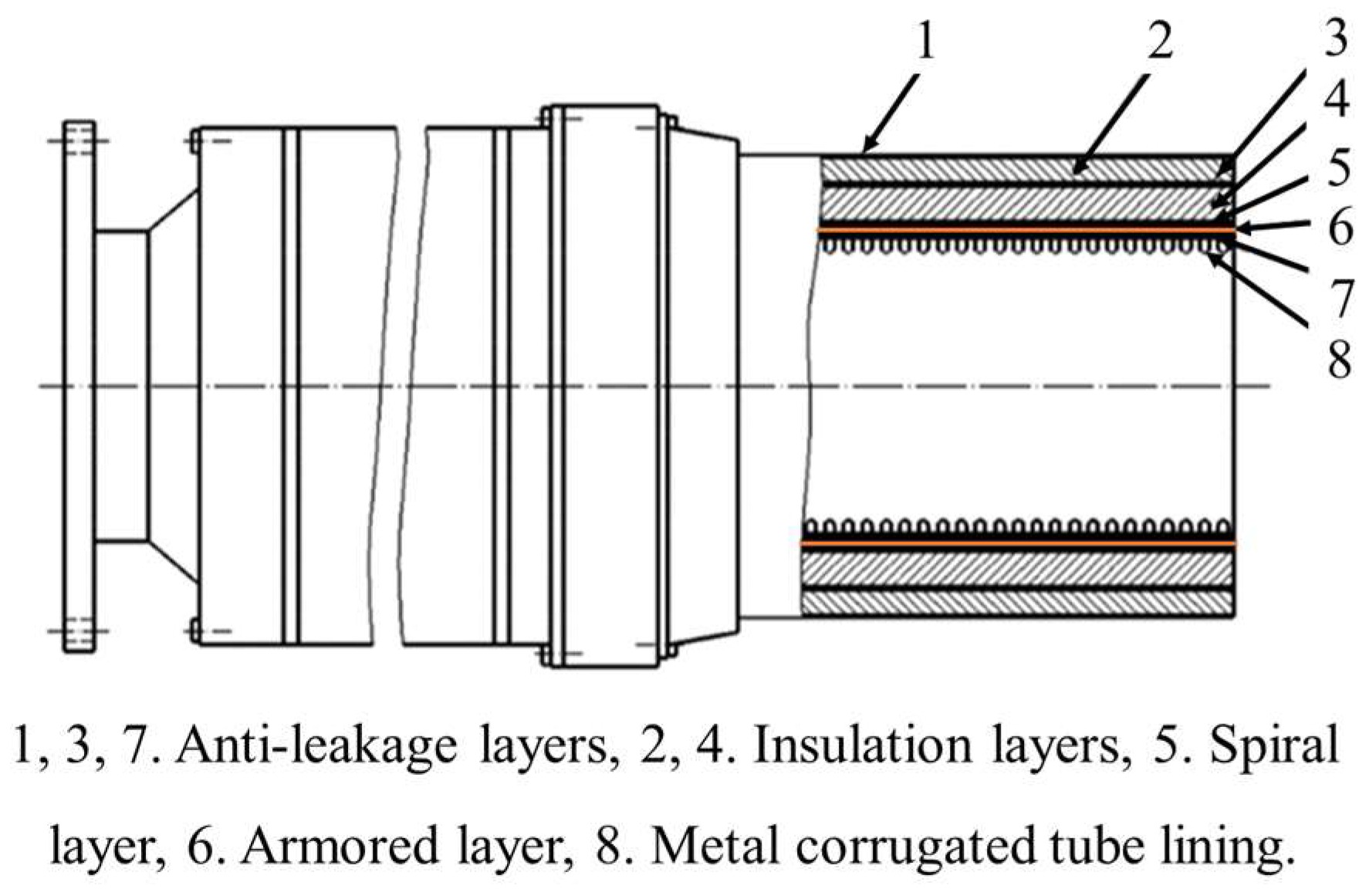
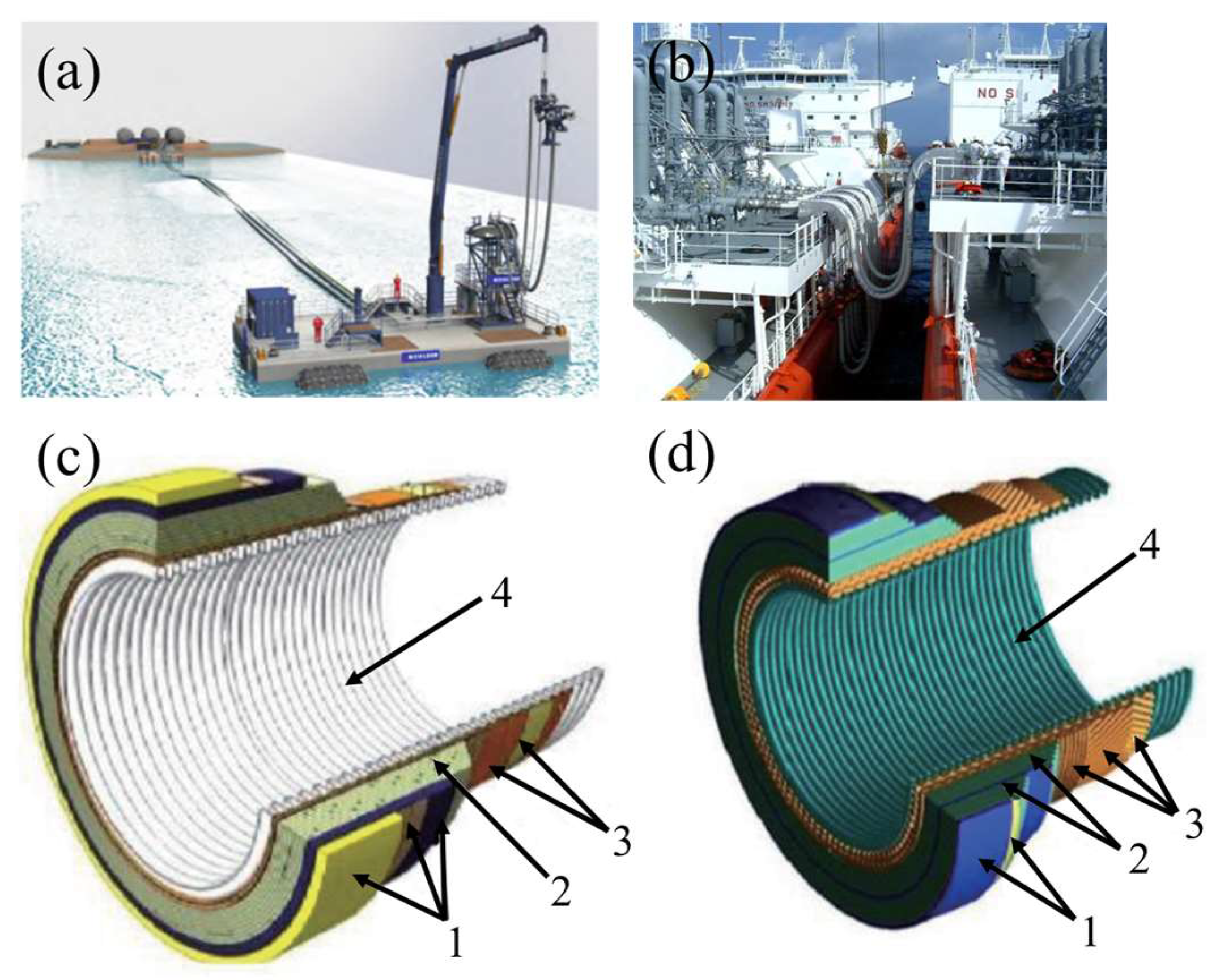
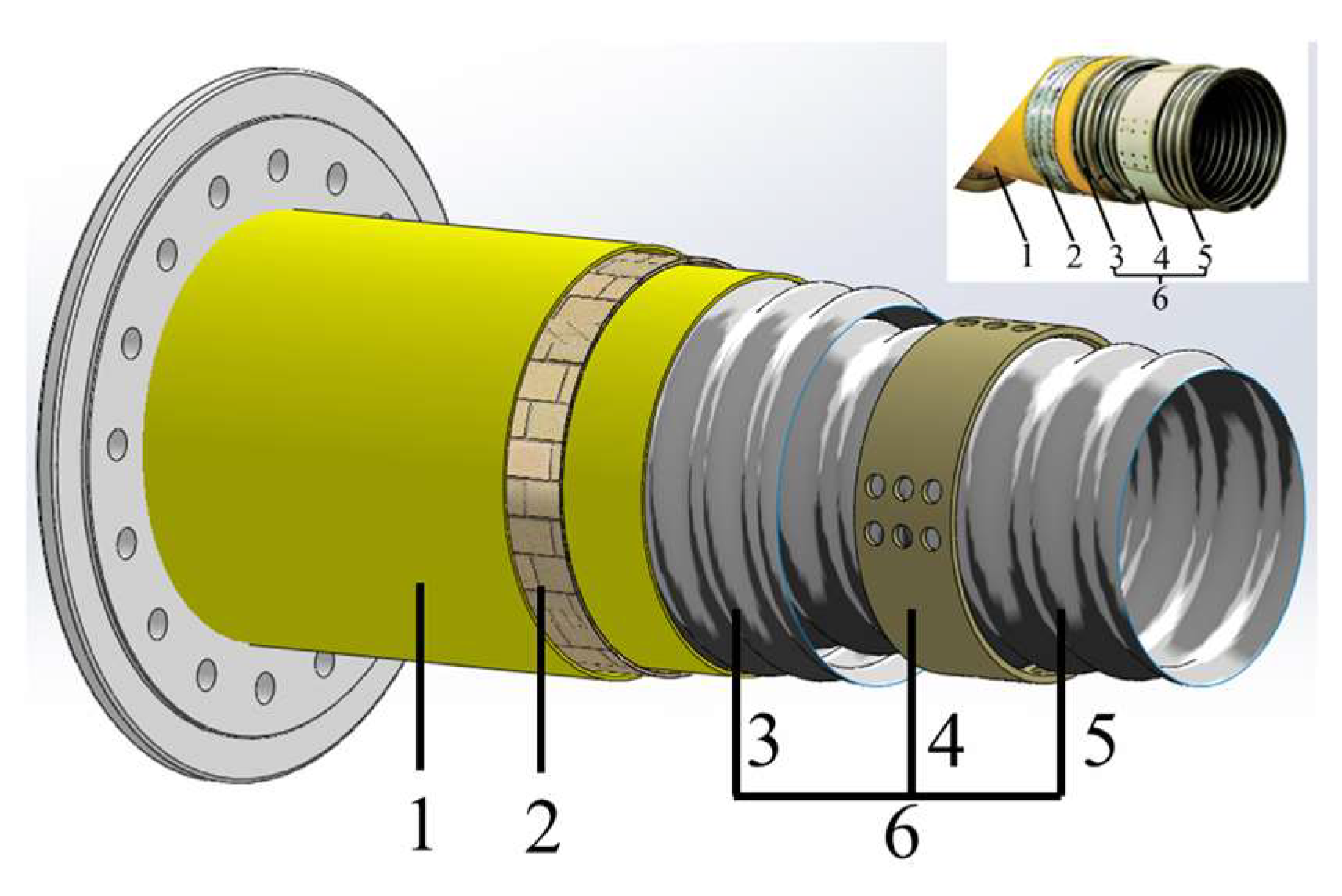
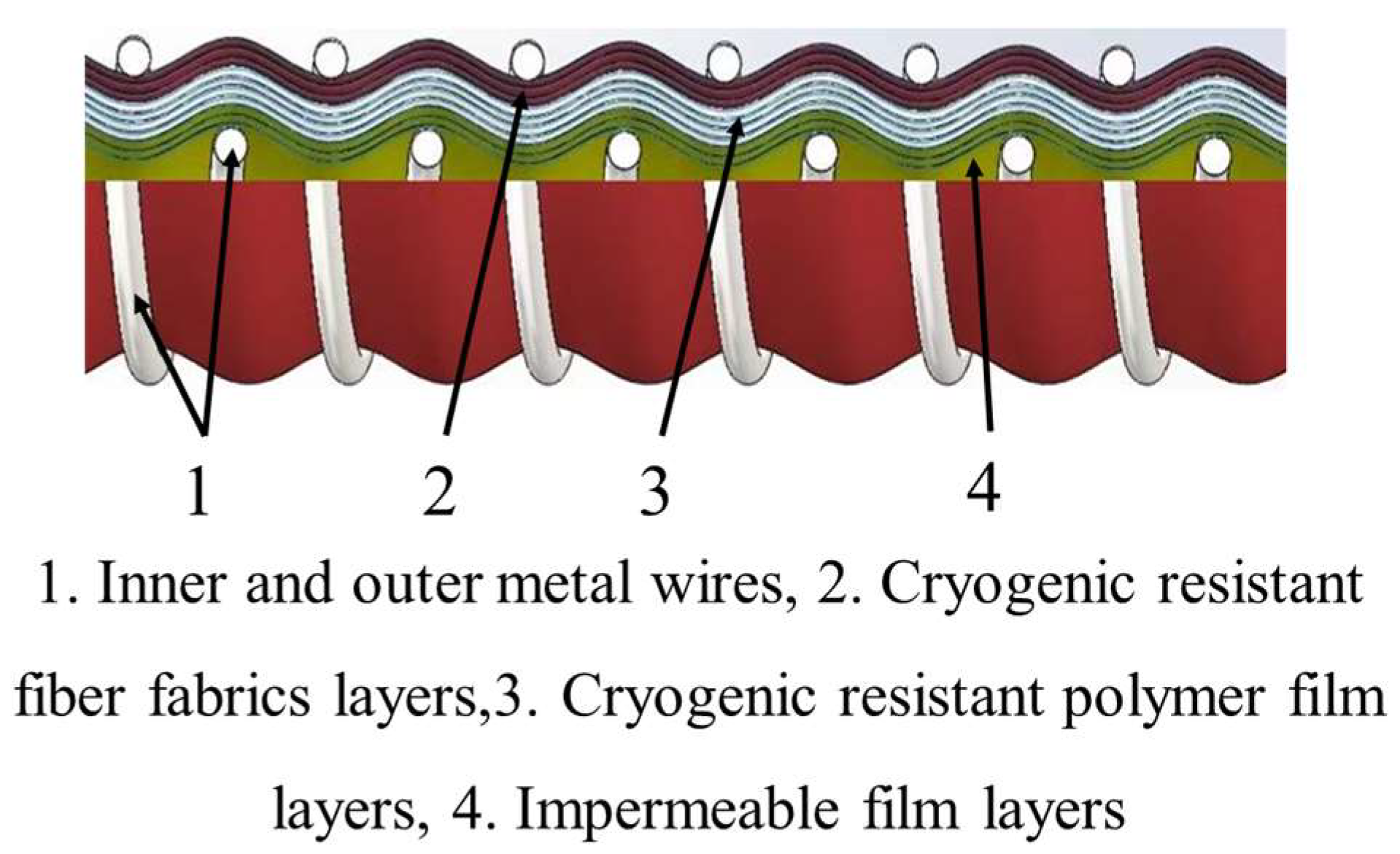
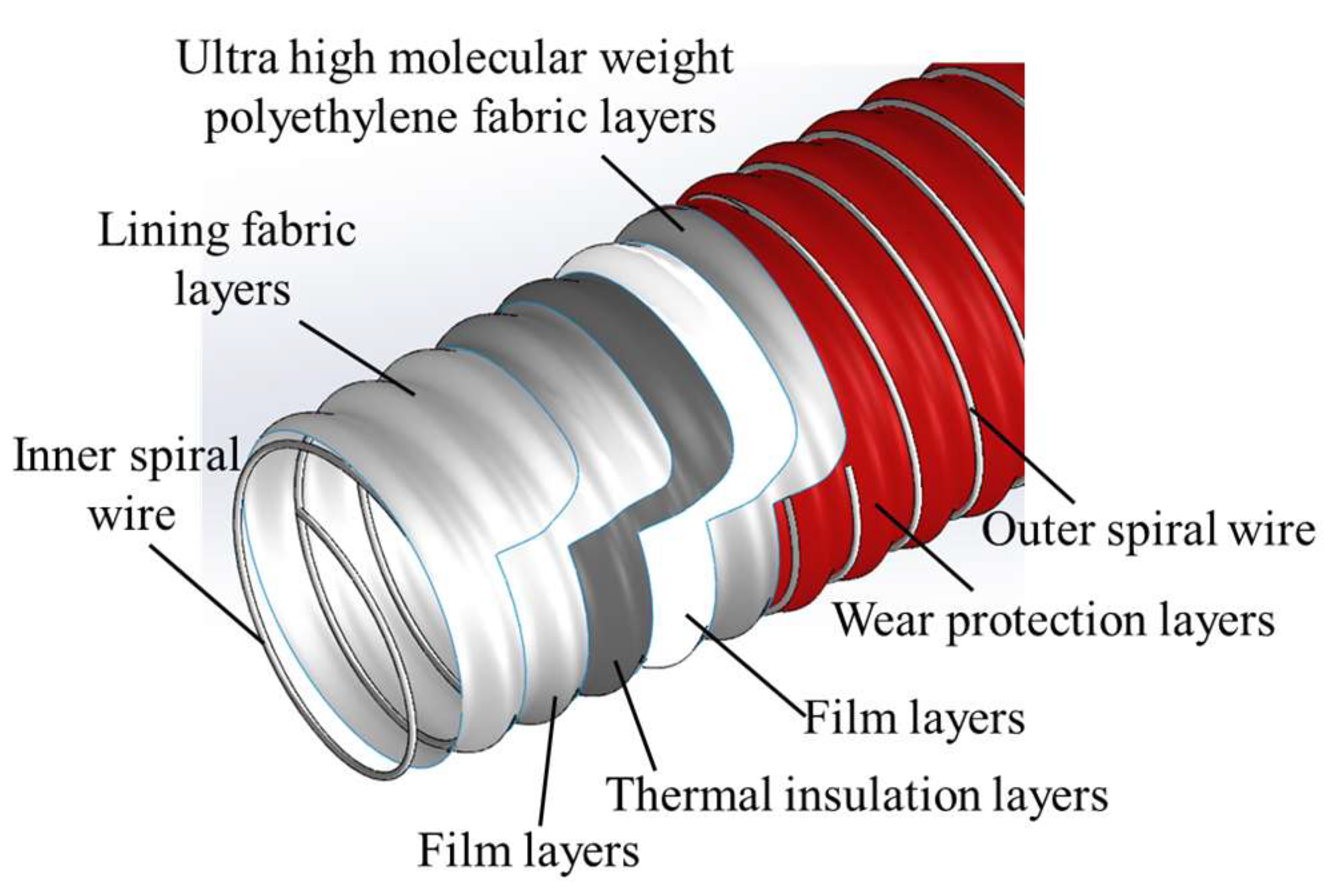

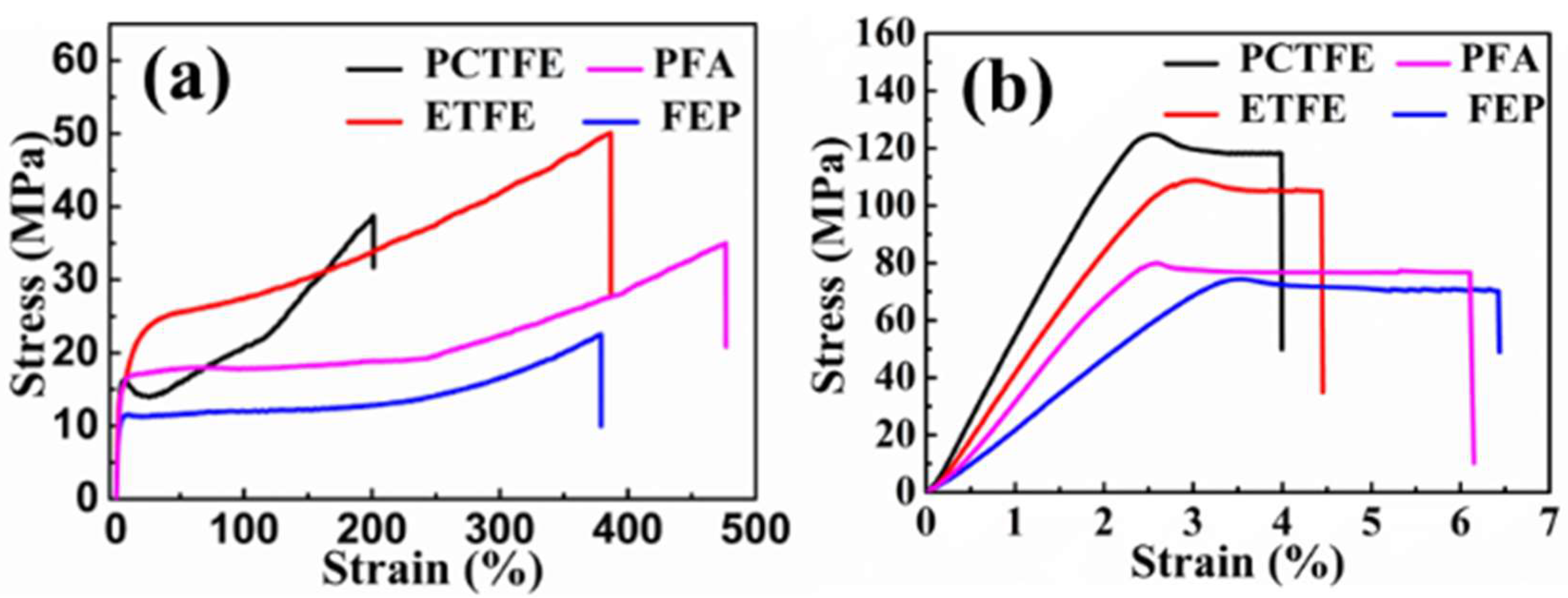

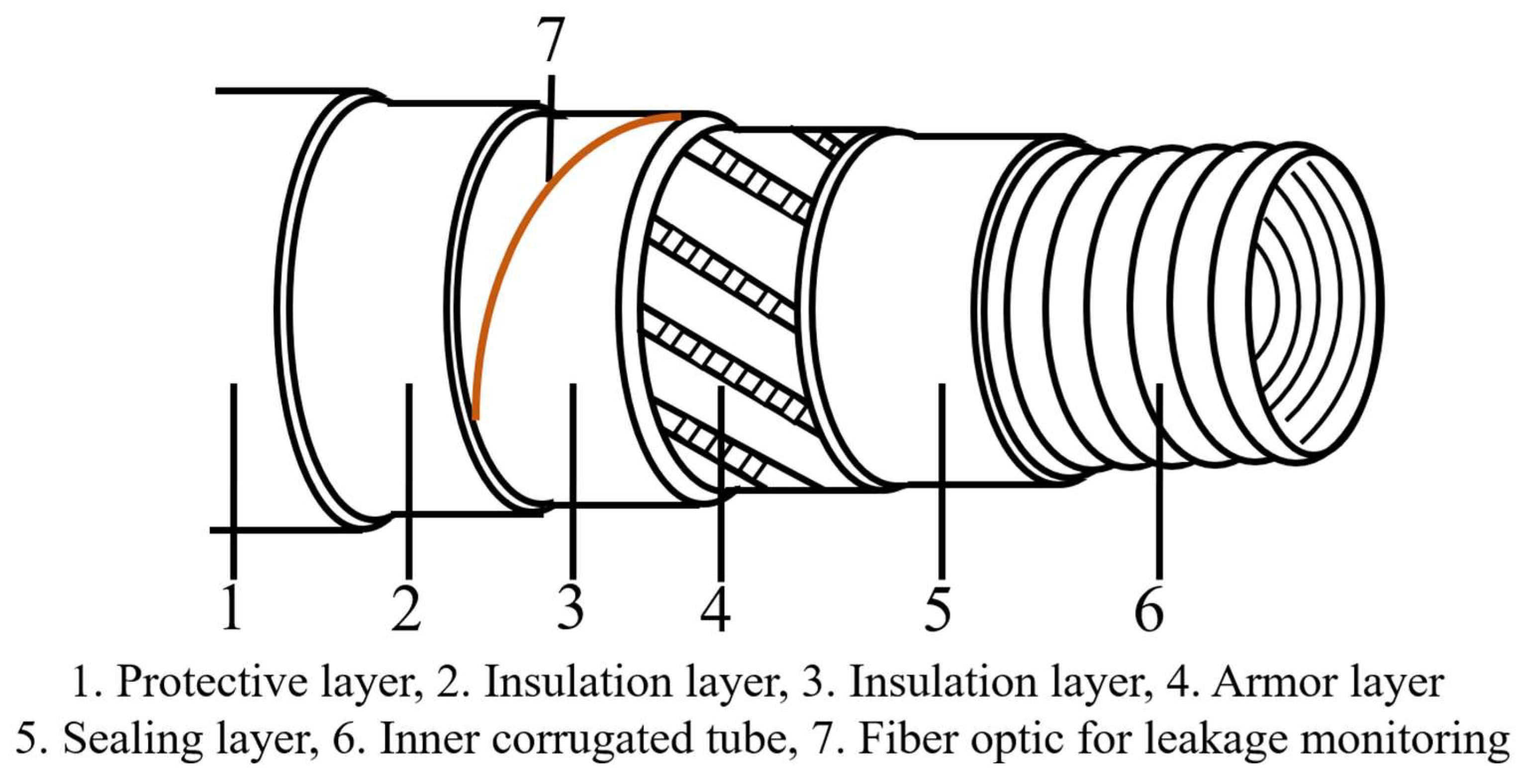
| Number | Layer Type | Performance Characteristics |
|---|---|---|
| 1 | Outer protective layer | 1. It prevents corrosion and wear of critical materials on the hoses wall from external environments. 2. The outer protective layers of the floating type hoses are wound by thermoplastic elastic material, while the suspended type hoses are wrapped by self-adhesive tape. |
| 2 | Insulation layer | 1. It prevents heat transfer, avoiding icing on the outer wall of the hoses and gasifying of the medium inside the hoses. 2. The insulation layers of the floating type hoses are wrapped by aerogel foam tape, while the suspended type hoses are wrapped by polyethylene foam tape. |
| 3 | Armored layer | 1. It is placed between the insulation layers and the metal inner tube, primarily bears axial loads, enhances the hose’s axial tensile strength. 2. It is wrapped by a double-layer of polyester fiber fabric. 3. The armored layer of the floating type hose is additionally equipped with wear-resistant strips and flat steel strips. 4. The armored layer of the the suspended type is wrapped with nylon braided tape. |
| 4 | Metal inner tube | 1. It is a thin-walled corrugated tube made of 316 L stainless steel. 2. It provids skeletal support and determins the inner diameter of hoses. 3. It is capable to withstand internal pressure loads during working. |
| Number | Layer Type | Performance Characteristics |
|---|---|---|
| 1 | Outer protective layer | 1. It prevents critical materials of hoses from wear or corrosion. 2. It is wrapped by thermoplastic polyethylene films according to the requirements. |
| 2 | Armored layer | 1. It protects the metal thin-walled corrugated tube, 2. It provides sufficient axial rigidity and tensile strength for the hose. 3. It is wound by two layers of flat steel strips. |
| 3 | Outer metal corrugated tube | 1. It is a part of the vacuum layer and bears some axial loads. 2. It is made of 316 L stainless steel. |
| 4 | Annular spacers | 1. It supports the inner and outer metal thin-walled corrugated tubes to form the interlayer gap. 2. Its thickness within 0.1 mm and the thermal conductivity is low. |
| 5 | Inner metal corrugated tube | 1. It is a part of the vacuum layer and bears some axial loads. 2. It provides skeletal support and determines the inner diameter of the hose. 3. It can withstand the internal pressure load during working. 4. It is made of 316 L stainless steel. |
| 6 | High vacuum insulation layer | 1. It consists of components 3, 4, and 5. 2. It reduces heat convection and radiation. 3. There are 10 layers reflective foil are wound on the outer wall of the inner metal corrugated tube to ensur the excellent insulation performance. |
| Number | Layer Type | Performance Characteristics |
|---|---|---|
| 1 | Outer protective hose based on bonded flexible hose technology. | 1. It prevents key materials of the hose from corrosion and wear. 2. The hose developed by Trelleborg company possesses good fatigue resistance. |
| 2 | Innovative and efficient insulation material + Leak monitoring system | 1. The material is designed to reduce heat loss within the structure so that no ice will form on the outer cover of the cryogenic hoses. 2. The material have excellent properties over the full range of temperatures (from room to cryogenic temperature). 3. The leak monitoring system based on optical fiber technology is included in the annular space to check the evolution of temperature within the structure and prevent any abnormal activity during working. |
| 3 | Inner hose derived from composite hose technology | 1. To achieve better sealing, this inner hose incorporates multiple polymeric film material and woven fabric material. |
| Performance | Tensile Strength/MPa | Elongation at Break/% | Elastic Modulus/GPa | ||||
|---|---|---|---|---|---|---|---|
| Material | |||||||
| 20 °C | −196 °C | 20 °C | −196 °C | 20 °C | −196 °C | ||
| PCTFE | 16.32 ± 1.02 | 127.78 ± 8.91 | 193.53 ± 9.01 | 4.01 ± 0.66 | 1.35 ± 0.10 | 5.65 ± 0.16 | |
| ETFE | 25.04 ± 1.61 | 100.16 ± 5.03 | 386.71 ± 7.93 | 4.31 ± 0.26 | 1.69 ± 0.08 | 4.85 ± 0.21 | |
| FEP | 11.52 ± 1.22 | 71.08 ± 4.87 | 379.04 ± 8.83 | 6.37 ± 0.19 | 0.59 ± 0.05 | 2.98 ± 0.20 | |
| PFA | 16.85 ± 1.33 | 80.79 ± 8.43 | 478.89 ± 7.68 | 6.32 ± 0.29 | 0.58 ± 0.04 | 3.28 ± 0.27 | |
| Insulation Materials | Density (kg/m3) | Thermal Conductivity (W/m·K) | Operating Temperature (°C) | Advantages | Disadvantages |
|---|---|---|---|---|---|
| Glass wool | 40~110 | 0.03~0.04 | −120~800 | Easy to form, low cost, and stable chemical properties | Prone to fiber debris |
| Foam asbestos | 20~45 | 0.035~0.041 | −50~400 | Good low-temperature performance and sound absorption | High volume weight |
| Aluminum silicate fiber felt | 70~120 | 0.034~0.12 | <1000 | Anti-seismic, Pressure-resistance and easy to form | Easy to produce dust |
| Polyurethane | 30~70 | 0.035 | <150 | Long service life and damp-proof insulation | Brittle and splintery |
| Aerogel | 100~170 | 0.011~0.016 | −196~1000 | Light, soft and Environmental | Easy to absorb water and high cost |
Disclaimer/Publisher’s Note: The statements, opinions and data contained in all publications are solely those of the individual author(s) and contributor(s) and not of MDPI and/or the editor(s). MDPI and/or the editor(s) disclaim responsibility for any injury to people or property resulting from any ideas, methods, instructions or products referred to in the content. |
© 2024 by the authors. Licensee MDPI, Basel, Switzerland. This article is an open access article distributed under the terms and conditions of the Creative Commons Attribution (CC BY) license (https://creativecommons.org/licenses/by/4.0/).
Share and Cite
Chen, Q.; Sun, Q.; Yan, J.; Cui, Y.; Yang, L.; Yang, X.; Wu, Z. Development and Recent Progress of Hoses for Cryogenic Liquid Transportation. Polymers 2024, 16, 905. https://doi.org/10.3390/polym16070905
Chen Q, Sun Q, Yan J, Cui Y, Yang L, Yang X, Wu Z. Development and Recent Progress of Hoses for Cryogenic Liquid Transportation. Polymers. 2024; 16(7):905. https://doi.org/10.3390/polym16070905
Chicago/Turabian StyleChen, Qiang, Qingguo Sun, Jia Yan, Yunguang Cui, Lufeng Yang, Xiaojing Yang, and Zhanjun Wu. 2024. "Development and Recent Progress of Hoses for Cryogenic Liquid Transportation" Polymers 16, no. 7: 905. https://doi.org/10.3390/polym16070905
APA StyleChen, Q., Sun, Q., Yan, J., Cui, Y., Yang, L., Yang, X., & Wu, Z. (2024). Development and Recent Progress of Hoses for Cryogenic Liquid Transportation. Polymers, 16(7), 905. https://doi.org/10.3390/polym16070905







